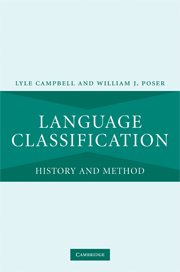Book contents
- Frontmatter
- Contents
- List of figures, tables, and charts
- Acknowledgments
- Preface
- 1 Introduction: how are languages shown to be related to one another?
- 2 The beginning of comparative linguistics
- 3 “Asiatic Jones, Oriental Jones”: Sir William Jones’ role in the raise of comparative linguistics
- 4 Consolidation of comparative linguistics
- 5 How some languages were shown to belong to Indo-European
- 6 Comparative linguistics of other language families and regions
- 7 How to show languages are related: the methods
- 8 The philosophical–psychological– typological–evolutionary approach to language relationships
- 9 Assessment of proposed distant genetic relationships
- 10 Beyond the comparative method?
- 11 Why and how do languages diversify and spread?
- 12 What can we learn about the earliest human language by comparing languages known today?
- 13 Conclusions: anticipating the future
- Appendix: Hypothesized distant genetic relationships
- References
- Index
2 - The beginning of comparative linguistics
Published online by Cambridge University Press: 22 September 2009
- Frontmatter
- Contents
- List of figures, tables, and charts
- Acknowledgments
- Preface
- 1 Introduction: how are languages shown to be related to one another?
- 2 The beginning of comparative linguistics
- 3 “Asiatic Jones, Oriental Jones”: Sir William Jones’ role in the raise of comparative linguistics
- 4 Consolidation of comparative linguistics
- 5 How some languages were shown to belong to Indo-European
- 6 Comparative linguistics of other language families and regions
- 7 How to show languages are related: the methods
- 8 The philosophical–psychological– typological–evolutionary approach to language relationships
- 9 Assessment of proposed distant genetic relationships
- 10 Beyond the comparative method?
- 11 Why and how do languages diversify and spread?
- 12 What can we learn about the earliest human language by comparing languages known today?
- 13 Conclusions: anticipating the future
- Appendix: Hypothesized distant genetic relationships
- References
- Index
Summary
And the whole earth was of one language, and of one speech … And they said, Go to, let us build us a city and a tower … And the Lord came down to see the city and the tower … And the Lord said, Behold, the people is one, and they have all one language … Go to, let us go down, and there confound their language, that they may not understand one another's speech … Therefore is the name of it called Babel; because the Lord did there confound the language of all the earth; and from thence did the Lord scatter them abroad upon the face of the earth.
(Genesis 11:1–9)Introduction
We begin our investigation of how language relationships are established by considering the earliest attempts at classifying languages into families. This history is revealing with respect to both how the field developed and why later scholars thought as they did. Our focus is on methods and on what we can learn from the procedures employed by the earliest practitioners of comparative linguistics.
The rise of the comparative method
Through voyages, conquests, trading, and colonization from the sixteenth century onward, Europe became acquainted with a wide variety of languages. Information on languages of Africa, Asia, and the Americas became available in the form of word lists, grammars, dictionaries, and religious texts, and significantly, Hebrew became known, through Johannes Reuchlin's (1506) grammar.
- Type
- Chapter
- Information
- Language ClassificationHistory and Method, pp. 13 - 31Publisher: Cambridge University PressPrint publication year: 2008



